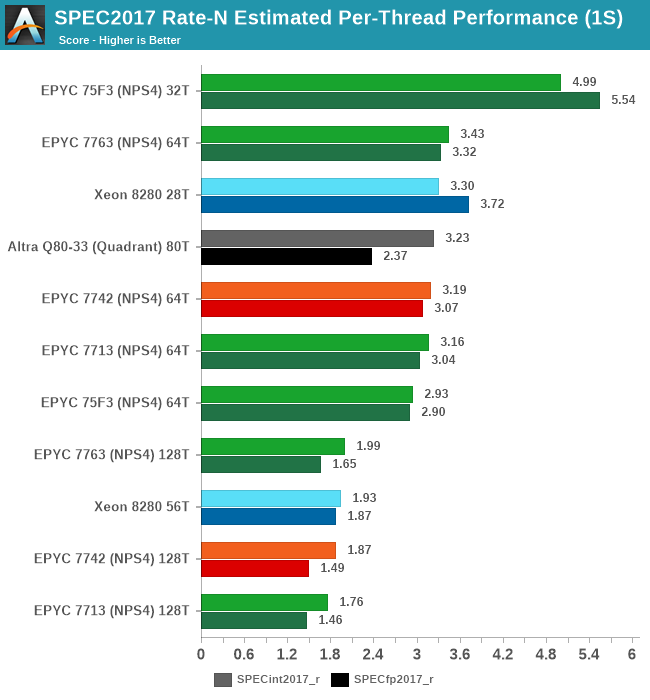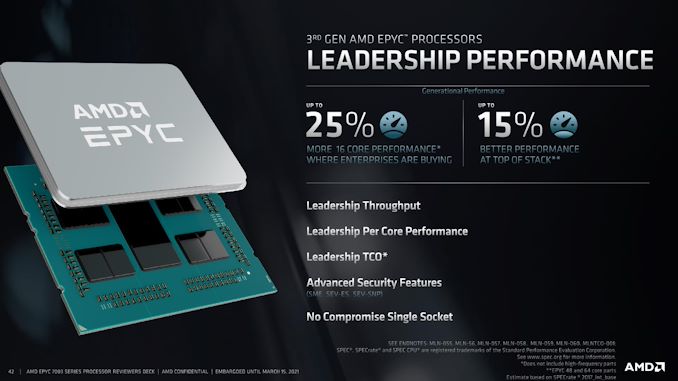AMD 3rd Gen EPYC Milan Review: A Peak vs Per Core Performance Balance
by Dr. Ian Cutress & Andrei Frumusanu on March 15, 2021 11:00 AM ESTDisclaimer June 25th: The benchmark figures in this review have been superseded by our second follow-up Milan review article, where we observe improved performance figures on a production platform compared to AMD’s reference system in this piece.
SPEC - Per-Core Win for "F"-Series 75F3
A metric that is actually more interesting than isolated single-thread performance, is actually per-thread performance in a fully loaded system. This actually is a measurement and benchmark figure that would greatly interest enterprises and customers which are running software or workloads that are possibly licensed on a per-core basis, or simply workloads that require a certain level of per-thread service level agreement in terms of performance.
It’s precisely this market that AMD is trying to target with its new “F”-series of processors, and this is where the new 75F3 comes into play. With 32 cores, 4 cores per chiplet with the full 256MB of L3 cache, and a base frequency of 2.95GHz, boosting up to 4.0GHz at a default 280W TDP, is the chip is squeezing out the maximum per-core performance while still offering a massive amount of multi-threaded performance.

At full load, this ends up with a massive per-thread performance leadership on the part of the 75F3, landing 45% ahead of the 7763 and 51% ahead of the Intel Xeon 8280.
It’s to be noted that limiting the thread count of the higher core-count SKUs will also result in a better per-thread performance metric, for example running a 7713 with only 32 threads will result in a SPECint2017 estimated score of 4.30 – the 75F3 still has a 16% advantage there even though its boost clock is only 8.8% higher at the peak – meaning the 75F3 is achieving higher effective frequencies. Unfortunately, we didn’t have enough time to do the same experiment on the equal 280W 7763 part.
AMD discloses that the biggest generational gains for the Milan stack is found in the lower core-count models, where for example the 7313 and the 7343 outperforms the 7282 and 7302 by 25%. Reason for this is that for example the new 7313 features double the L3 cache, and all the new CPUs are boosting higher with respectively higher TDPs, increasing to 150/190W from 120/155W, as well as landing in at +50% higher price points when comparing generation to generation.











120 Comments
View All Comments
gustavowoltmann - Saturday, March 27, 2021 - link
https://www.anandtech.com/Calin - Tuesday, March 16, 2021 - link
That's "team Anandtech" but from the times when the site was done by a single person.I used to read Tom's Hardware, then it and Anandtech (sometime before 2000 I think, the site was started in 1997), then Anandtech only.
Lots of quality hardware information, even though at first the site sometime covered antiviruses and some other software.
Considering the entire history, reviewers other than Anand are a recent phenomenon :)
MenhirMike - Monday, March 15, 2021 - link
I wonder if AMD is going to add 120 W CPUs again - EPYC Rome had 4 CPUs with only 4 memory channels of bandwidth, but with a lower TDP, including the EPYC 7282.zanon - Monday, March 15, 2021 - link
They do have an EPYC Embedded (3000 series) line that's still Zen 1. Maybe they'll move that to Zen 3 and that's where the low TDP stuff will go?Foeketijn - Monday, March 15, 2021 - link
Yes, it's a shame those type of parts didn't really get attention yet. It's really great you can get 128 Cores and 256 threads in a 2U server, But if you just need 20 VM's running on a super stable platform, 16 threads and 50 Watts are more than enough.Spunjji - Friday, March 19, 2021 - link
I believe they're leaving that segment to Romepowerarmour - Monday, March 15, 2021 - link
ARM is going to be the tech to watch in this space IMHO, especially with NVIDIA's upcoming weight behind it.TheinsanegamerN - Monday, March 15, 2021 - link
2014 called and wants its prediction back.powerarmour - Monday, March 15, 2021 - link
Ampere Altra responded to the call, but is currently engaged.MenhirMike - Monday, March 15, 2021 - link
It's not as egregious as "Linux on the Desktop": ARM on the server is actually gaining foothold, especially for Cloud-hosted companies.Though x86-64 will be around for a LONG time - ARM might (and likely will) get a nice Marketshare, but it will not seriously threaten x86-64 for decades, if ever.
One thing that ARM is sorely lacking are some workstations to test stuff on. The Ampere eMag was based on ancient hardware, Raspberry Pi isn't specced nearly the same, and I'm not putting an Ampere Altra on my desk.